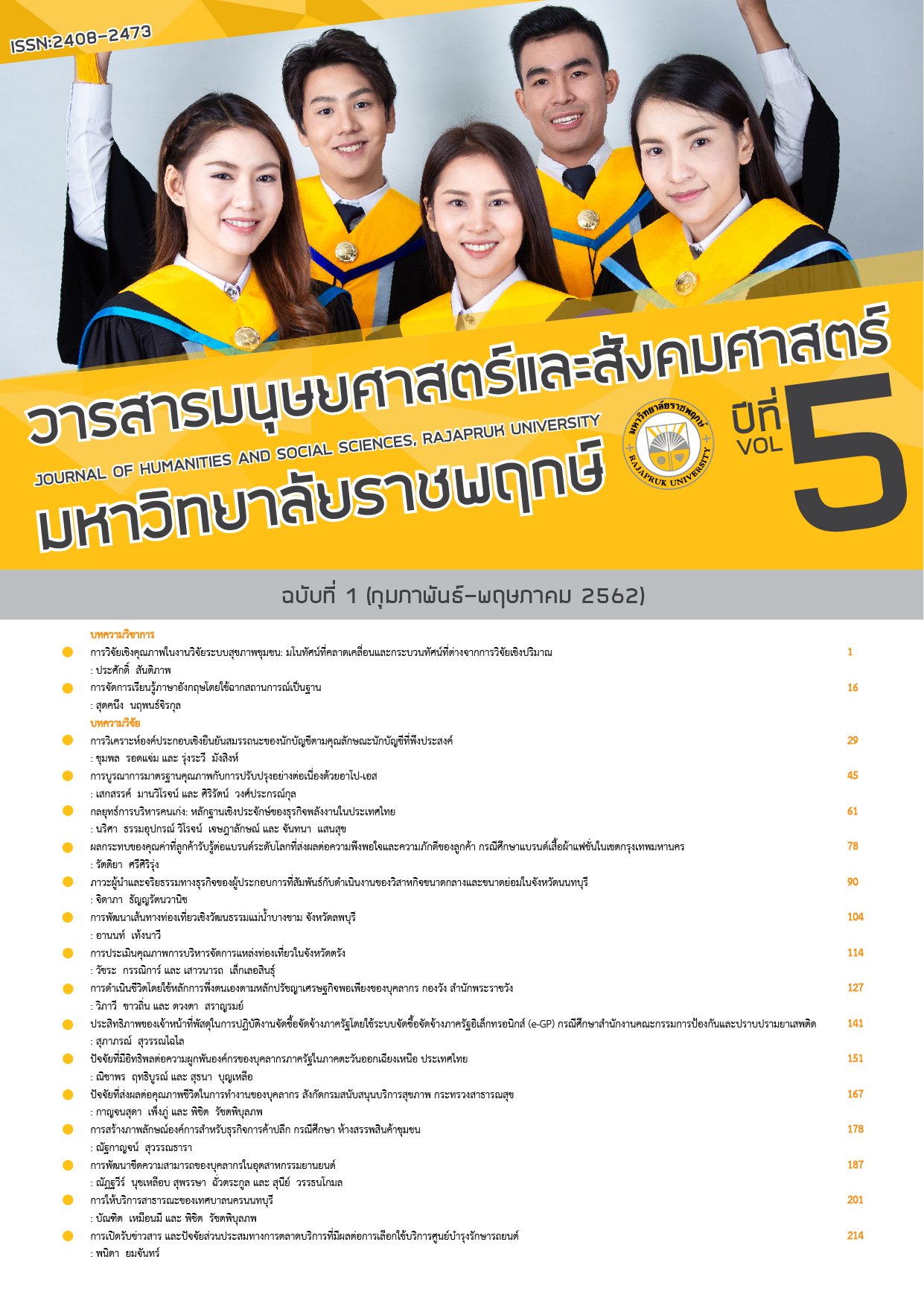การออกแบบการเรียนรู้ภาษาอังกฤษโดยใช้ฉากสถานการณ์เป็นฐาน
##plugins.themes.bootstrap3.article.main##
摘要
บทความวิชาการนี้มีวัตถุประสงค์เพื่อนำเสนอแนวทางการจัดการเรียนรู้ภาษาอังกฤษโดยใช้ฉากสถานการณ์เป็นฐาน ซึ่งประกอบไปด้วยการกำหนดวัตถุประสงค์การเรียนรู้ การสร้างฉากสถานการณ์ ขั้นตอนการจัดการเรียนรู้ 3 ขั้นตอน ได้แก่ 1) เผชิญฉากสถานการณ์ 2) ต่อสู้กับปัญหา และ 3) เรียนรู้ด้วยตนเอง บทบาทผู้สอน บทบาทผู้เรียน และผลลัพธ์การเรียนรู้ การจัดการเรียนรู้ภาษาอังกฤษโดยใช้ฉากสถานการณ์เป็นฐานเหมาะกับผู้เรียนในระดับปริญญาตรี สามารถพัฒนาทักษะภาษาอังกฤษ
ทั้ง 4 ทักษะของผู้เรียนจากการเรียนรู้ผ่านสถานการณ์ที่ใกล้เคียงกับความจริง ผู้เรียนเห็นความเชื่อมโยงของการใช้ภาษาอังกฤษกับการทำงาน ผลที่ได้จากการจัดการเรียนรู้นี้ยังช่วยพัฒนาทักษะการทำงานร่วมกันเป็นทีม ทักษะการตัดสินใจ และทักษะการเรียนรู้ด้วยตนเองซึ่งเป็นคุณลักษณะที่สำคัญของบัณฑิตในศตวรรษที่ 21 และยังเป็นการเตรียมความพร้อมให้กับบัณฑิตในการเข้าสู่โลกการทำงาน
##plugins.themes.bootstrap3.article.details##
参考
วรวรรธน์ ศรียาภัย และคณะ. (2553). ความต้องการคุณลักษณะบัณฑิตทางภาษาและการสื่อสารของสถานประกอบการ. วารสารช่อพะยอม, 21: 36 - 50.
Brush, T.A., & Saye, J.W. (2002). A summary of research exploring hard and soft scaffolding for teachers and students using a multimedia supported learning environment. The Journal of Interactive Online Learning, 1(2): 2 - 12.
Education First. (2017). EF English Proficiency Index. Retrieved on June 15th, 2018, from www.ef.com/epi
Educational Testing Service. (2018). 2017 TOEIC Report on Test Takers Worldwide. Retrieved on June 15th, 2018, from http://www.etsglobal.org/Global/Eng/content/ download/ 23691/378432/version/1/file/LR+2017+Worldwide+Report.pdf
Errington, E.P. (2010). Preparing graduates for the professions using scenario-based learning. Brisbane: Post Pressed.
Fisher, D., & Frey, N. (2014). Better learning through structured teaching: A framework for the gradual release of responsibility. 2nd ed. Alexandria, Virginia: Association of Supervision and Curriculum Development.
Frey, N., & Fisher, D. (2009). The release of learning. Principle Leadership, February 2009: 18 - 22.
Global English. (2010). The globalization of English report: Globalization accelerates need for business English communication skills. Retrieved on September 13th, 2017, from http://static.globalenglish.com/files/case_studies/ GlobEng_ ResearchSt_GlobEngRep_EN-US_FINAL.pdf
Hammond, J., & Gibbons, P. (2001). What is scaffolding? In J. Hammond (Ed.), Scaffolding: Teaching and learning in language and literacy education (pp. 1 - 14). New Town, NSW: Primary English Teaching Association.
Heinich, R., et al. (1996). Instructional media and technologies for learning. Englewood Cliffs, NJ: Merrill.
Kindley, R.W. (2002). Scenario-based e-learning: A step beyond traditional e-learning. Retrieved on March 18th, 2016, from http://www.learningcircuits.com/2002/ may2002/kindley.html
McKinsey Global Institute. (2017). A future that works: Automation, employment, and productivity. Retrieved on June 2nd, 2017, from www.mckinsey.com/MGI-A-future-that-works-Full-report%20(1).pdf
Mery, Y., & Blakiston, R. (2010). Scenario-based e-learning: Putting the student in the driver’s seat. 26th Annual Conference on Distance Teaching and Learning. August 4 - 6, 2010. Wisconsin: University of Wisconsin.
Sinlarat, P. (2015). Future teacher’s roles: Preparing students to teach themselves. Journal of Social Sciences and Humanities, Rajapruk University, 1(1): 1 - 8. Retrieved on June 25th, 2018, from https://www.tci-thaijo.org/index.php/rpu/article/ view/112118/87382 (in Thai)
Sriyabhaya, W., et al. (2010). The Needs of Entrepreneurs to Characteristics of Graduates in Language and Communication. Chophayom Journal, 21: 36 - 50. (in Thai)

